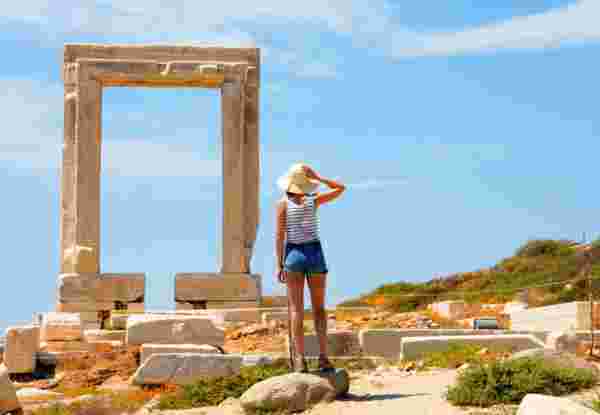War, Plague and Death in Classical Athens

The site of Kerameikos, at the outskirts of the ancient city and few meters northern of the ancient marketplace but now near the center of modern Athens, is one of the most famous and most significant historic cemeteries of the ancient world. It was an immense burial ground from the Late Bronze Age, let’s say before 1200 BCE and the creation of the ancient city itself, until the Roman period in the first centuries of the common era. In this place, the Athenians of the Classical Period (5th century BCE) developed a system of roads lined with elaborate terrace walls and an outstanding set of grave monuments.

Statues of dead warriors, mourning figures in relief and enormous marble vases were placed and designed for high visibility for those entering and leaving the city, forming an open-air exhibition with the finest samples of the ancient Greek funerary sculpture.
Our image in question is a very-well executed and lavish funerary marble relief in the form of a temple, where the pediment at the top is supported by two walls, thereby providing a frame and creating an appropriate space around the figures.

The seated woman is superbly carved; in sandals, disc earring, an amazing draped dress and a mantle that slides down and over the back of her head. The one hand rests on the back of the chair and holds a bird. With the other hand she wraps the baby with great affection; the later extends his little hand toward her. Both figures are described realistically and with a warmly sentiment and tenderness. At first glance we would assume that this was a mother and her child, but the inscription carved above the scene informs us that these figures represent a grandmother and grandchild, both of whom are dead:
“I hold my daughter’s dear child, whom I held on my lap, when we were alive and looked at the rays of the sun with our eyes. And now being dead, I hold it dead”
Although it is not certain when exactly they died and what caused this dreadful event, most likely it was the terrible effect of the plague that reached the city of Athens in 430 BCE.
But let’s follow the events.
The years between 431-421 BCE marked an unparalleled period of Athens history. The city under the leadership of the great Athenian statesman Perikles[1] had already accomplished part of the Acropolis building program (Parthenon included) celebrating the great past victories against the Persians and its supremacy over the rest of the Greek city-states, foe and alike. However, in 432 BCE, not even halfway into a thirty-year peace concluded by the two great Greek powers, Sparta (the main rival of Athens) voted to go to war against Athens. At that point, Perikles convinced all those living outside the city walls and in the countryside to move within them for better protection. Thucydides[2], the great Athenian historian of the 5th century BCE, told us that the “people were deeply troubled and distressed at abandoning their houses, but also their country shrines”.
The following two summers of 431 and 430 BCE, the Spartan King led his army into Athens and invaded the city; this event is now conceived as the beginning of the calamitous war that divided the Greeks for the next few decades, namely the famous Peloponnesian War[3].
The plague arrived in Athens shortly thereafter. For the city this was the worst moment of the first war decade and eventually of its entire history. The epidemic killed thousands upon thousands of Athenian citizens and their families, and lasted for approximately 2 years. The losses are clearly attested in the literary sources that mention that the Athenians lost 4,400 hoplites (foot soldiers), 300 cavalry and “an indeterminable number of common people”. In other words, we estimate that between 430 and 426 BCE Athens lost a third of her male population, approximately 15,000 citizens. It is further unknown how many Athenian women, children, foreigners and slaves died from the disease. Perikles died of the plague too and doubtless his death was a turning point in the Athenian politics and, by extension, the war and the entire society.

During the last quarter of the 5th century BCE women and children became a major theme of the Athenian thought. An increased interest in maturation festivals, drama plays and decrees promoting childbearing clearly demonstrates that suddenly they realized how important the next generations would be to the future of their city.
The same concern in children also appears in Athenian funerary art, specifically on marble grave monuments and funerary vases. It is estimated that about 40 percent of all sculpted tombstones dating between 430 and 400 BCE show children, and the majority depicts young boys.

Our last sample (image below/right etc), executed around 420 BCE, portrays a young woman holding a bird out to her very young brother, almost an infant, who is reaching up to grasp it. The two children may have died together, or alternatively, at different times. Whether or not, this gravestone was set up later on by their bereaved parents to consolidate and commemorate their grief. Both image and inscription reflect emotion and distress for the loss of children, who had left their home for the house of Hades.
War, plague and eventually death can alter the fabric of any society. For the ancient Athenians, losing a quarter of the male citizen population during the Peloponnesian War was not a problem that could be fixed quickly. Hence, the loss of a child under these circumstance was particularly devastating and had now become extremely important for the future of their households and for their city too.
By Nota Karamaouna
[1] https://en.wikipedia.org/wiki/Pericles
Feeling Ready?
From our blog

Honeymoon in Naxos: A Complete Guide
READ MORE
Visiting Athens with Kids: A helpful Guide
READ MORE
Paros for Seniors: Tips and Itinerary
READ MORE
Best Resorts in Greece for Families: Your Ultimate 2025 Guide
READ MORE
How to Enjoy Santorini for Seniors
READ MORE
Honeymoon in Paros Island
READ MORE
Rome Travel Guide: What to Do, When to go and Where to Go
READ MORE
The Best Greek Islands for Couples, According to a Luxury DMC
READ MORE
Discover Milan: Top Attractions
READ MORE



